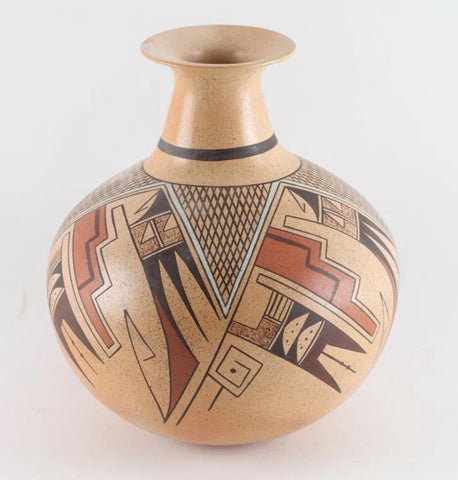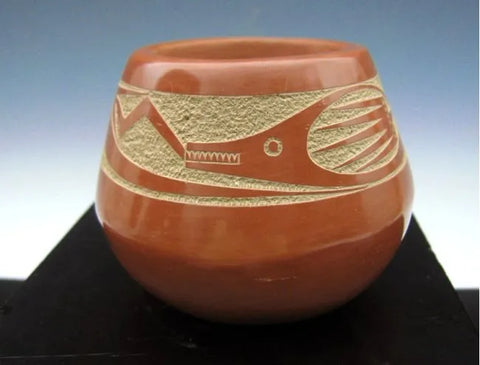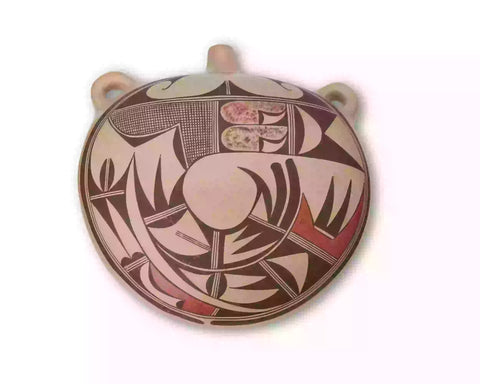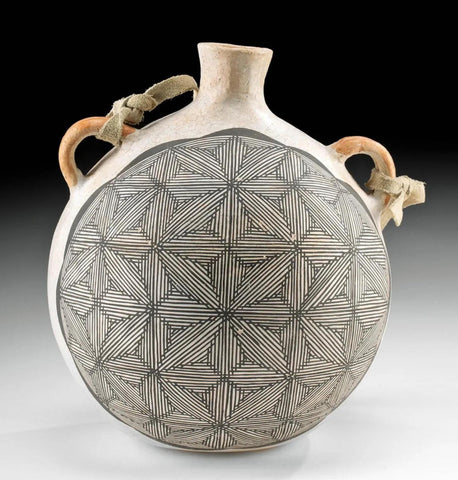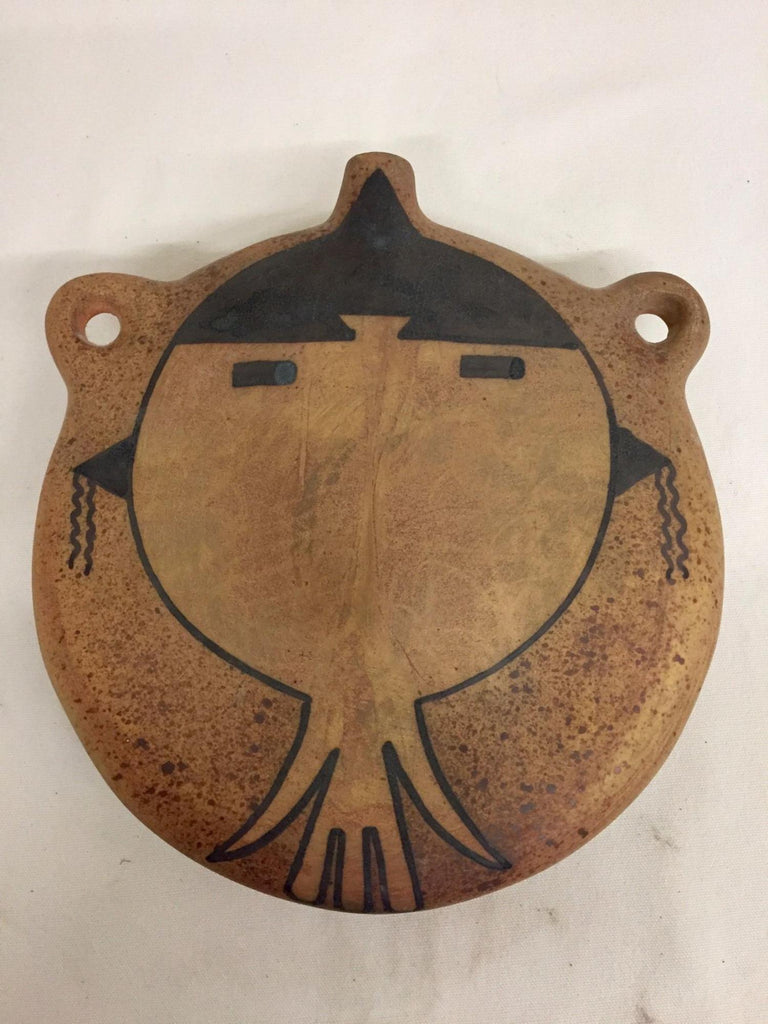
Extremely Nice Chakoptewa Pottery Canteen by Michael Hawley (American, 1948-2012), Ca #1441 SOLD
$ 500.00
Extremely Nice Chakoptewa Pottery Canteen by Michael Hawley (American, 1948-2012), Ca. 1980's #1441
Discription: #1441 Extremely Nice Chakoptewa Pottery Canteen by Michael Hawley (American, 1948-2012), Ca 1980's
Dimensions: Approx. 8-1/2”w x 2-1/4” deep
Condition: Very good for its age
Provenance: Cheryl M. Carpentier, New River, AZ.
Michael Hawley (1948-2012) Chakoptewa: Michael Hawley, Chakoptewa, formerly of Scottsdale, Arizona, was the only contemporary potter creating true Sikyatki Polychrome pottery vessels in the same manner as they were originally made from the 14th through the 17th centuries. Hawley called this pottery "Chakoptewa Polychrome," Chakoptewa being his adopted Hopi name.
Hawley used only hand-ground clay dug on Antelope Mesa on the Hopi Reservation and he hand coiled, shaped, polished, painted and coal fired each of the pots in a firing pit he constructed himself. All of his pigments were made by hand from minerals and plants indigenous to the Hopi Mesas and each of his painted designs is original and within the Sikyatki designs tradition.
Mike Hawley's pieces are original and unique pieces of contemporary ceramic art inspired by ancient tradition. They are not copies or replicas. We received word from the Hawley family that Michael passed away on April 24, 2012. (Source: Adobe Gallery)
You can check out how Michael made his pottery at https://www.youtube.com/watch?v=BhgkP-6SdAg
“Pueblo pottery is made using a coiled technique that came into northern Arizona and New Mexico from the south, some 1500 years ago. In the four-corners region of the US, nineteen pueblos and villages have historically produced pottery. Although each of these pueblos use similar traditional methods of coiling, shaping, finishing and firing, the pottery from each is distinctive. Various clays gathered from each pueblo’s local sources produce pottery colors that range from buff to earthy yellows, oranges, and reds, as well as black. Fired pots are sometimes left plain and other times decorated—most frequently with paint and occasionally with appliqué. Painted designs vary from pueblo to pueblo, yet share an ancient iconography based on abstract representations of clouds, rain, feathers, birds, plants, animals and other natural world features.
Tempering materials and paints, also from natural sources, contribute further to the distinctiveness of each pueblo’s pottery. Some paints are derived from plants, others from minerals. Before firing, potters in some pueblos apply a light colored slip to their pottery, which creates a bright background for painted designs or simply a lighter color plain ware vessel. Designs are painted on before firing, traditionally with a brush fashioned from yucca fiber.
Different combinations of paint color, clay color, and slips are characteristic of different pueblos. Among them are black on cream, black on buff, black on red, dark brown and dark red on white (as found in Zuni pottery), matte red on red, and polychrome—a number of natural colors on one vessel (most typically associated with Hopi). Pueblo potters also produce undecorated polished black ware, black on black ware, and carved red and carved black wares.
Making pueblo pottery is a time-consuming effort that includes gathering and preparing the clay, building and shaping the coiled pot, gathering plants to make the colored dyes, constructing yucca brushes, and, often, making a clay slip. While some Pueblo artists fire in kilns, most still fire in the traditional way in an outside fire pit, covering their vessels with large potsherds and dried sheep dung. Pottery is left to bake for many hours, producing a high-fired result.
Today, Pueblo potters continue to honor this centuries-old tradition of hand-coiled pottery production, yet value the need for contemporary artistic expression as well. They continue to improve their style, methods and designs, often combining traditional and contemporary techniques to create striking new works of art.” (Source: Museum of Northern Arizona)
Discription: #1441 Extremely Nice Chakoptewa Pottery Canteen by Michael Hawley (American, 1948-2012), Ca 1980's
Dimensions: Approx. 8-1/2”w x 2-1/4” deep
Condition: Very good for its age
Provenance: Cheryl M. Carpentier, New River, AZ.
Michael Hawley (1948-2012) Chakoptewa: Michael Hawley, Chakoptewa, formerly of Scottsdale, Arizona, was the only contemporary potter creating true Sikyatki Polychrome pottery vessels in the same manner as they were originally made from the 14th through the 17th centuries. Hawley called this pottery "Chakoptewa Polychrome," Chakoptewa being his adopted Hopi name.
Hawley used only hand-ground clay dug on Antelope Mesa on the Hopi Reservation and he hand coiled, shaped, polished, painted and coal fired each of the pots in a firing pit he constructed himself. All of his pigments were made by hand from minerals and plants indigenous to the Hopi Mesas and each of his painted designs is original and within the Sikyatki designs tradition.
Mike Hawley's pieces are original and unique pieces of contemporary ceramic art inspired by ancient tradition. They are not copies or replicas. We received word from the Hawley family that Michael passed away on April 24, 2012. (Source: Adobe Gallery)
You can check out how Michael made his pottery at https://www.youtube.com/watch?v=BhgkP-6SdAg
“Pueblo pottery is made using a coiled technique that came into northern Arizona and New Mexico from the south, some 1500 years ago. In the four-corners region of the US, nineteen pueblos and villages have historically produced pottery. Although each of these pueblos use similar traditional methods of coiling, shaping, finishing and firing, the pottery from each is distinctive. Various clays gathered from each pueblo’s local sources produce pottery colors that range from buff to earthy yellows, oranges, and reds, as well as black. Fired pots are sometimes left plain and other times decorated—most frequently with paint and occasionally with appliqué. Painted designs vary from pueblo to pueblo, yet share an ancient iconography based on abstract representations of clouds, rain, feathers, birds, plants, animals and other natural world features.
Tempering materials and paints, also from natural sources, contribute further to the distinctiveness of each pueblo’s pottery. Some paints are derived from plants, others from minerals. Before firing, potters in some pueblos apply a light colored slip to their pottery, which creates a bright background for painted designs or simply a lighter color plain ware vessel. Designs are painted on before firing, traditionally with a brush fashioned from yucca fiber.
Different combinations of paint color, clay color, and slips are characteristic of different pueblos. Among them are black on cream, black on buff, black on red, dark brown and dark red on white (as found in Zuni pottery), matte red on red, and polychrome—a number of natural colors on one vessel (most typically associated with Hopi). Pueblo potters also produce undecorated polished black ware, black on black ware, and carved red and carved black wares.
Making pueblo pottery is a time-consuming effort that includes gathering and preparing the clay, building and shaping the coiled pot, gathering plants to make the colored dyes, constructing yucca brushes, and, often, making a clay slip. While some Pueblo artists fire in kilns, most still fire in the traditional way in an outside fire pit, covering their vessels with large potsherds and dried sheep dung. Pottery is left to bake for many hours, producing a high-fired result.
Today, Pueblo potters continue to honor this centuries-old tradition of hand-coiled pottery production, yet value the need for contemporary artistic expression as well. They continue to improve their style, methods and designs, often combining traditional and contemporary techniques to create striking new works of art.” (Source: Museum of Northern Arizona)
Related Products
Sold out
Sold out








